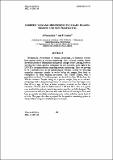Por favor, use este identificador para citar o enlazar a este item:
http://hdl.handle.net/10261/6600COMPARTIR / EXPORTAR:
 SHARE
BASE SHARE
BASE
|
|
| Visualizar otros formatos: MARC | Dublin Core | RDF | ORE | MODS | METS | DIDL | DATACITE | |

| Campo DC | Valor | Lengua/Idioma |
|---|---|---|
| dc.contributor.author | Fernández Torres, José | - |
| dc.contributor.author | Luzón, Francisco | - |
| dc.date.accessioned | 2008-08-14T07:00:14Z | - |
| dc.date.available | 2008-08-14T07:00:14Z | - |
| dc.date.issued | 2002 | - |
| dc.identifier.citation | Física de la Tierra 2002, 14, 109-126 | en_US |
| dc.identifier.issn | 0214-4557 | - |
| dc.identifier.uri | http://hdl.handle.net/10261/6600 | - |
| dc.description.abstract | Traditionally, observations of seismic, hydrologic, or fumarolic activity have proven useful in volcano monitoring. Since volcanic activity almost inevitably produces deformation and gravity changes before, during, between and after the events, geodetic techniques are now included, in the light of the IAVCEI’s recommendations regarding routine monitoring. They are proving to be a powerful tool in the monitoring of volcanic activity by detecting anomalies sometimes months or weeks before the magma flow leads to earthquakes or other eruption precursors. The Canary Islands, with a population of about 1.8 million people, are located less than 100... (Leer más) km from the African continent. Despite being on a passive margin, they are a volcanic archipelago with a long standing history of volcanic activity that began more than 40 m.y. ago. At least a dozen eruptions occurred on the islands of Lanzarote, Tenerife, and La Palma between 1500 and 1971. This is a typical case in which the volcanic monitoring system must be carefully designed. The system must be efficient, but must also make full use of existing facilities and have acceptable installation and running costs, in line with the current level of activity. This paper describes a proposal for the geodetic monitoring system in Canary Islands using terrestrial and space techniques. | en_US |
| dc.description.sponsorship | This research has been funded through the Ministry of Science and Technology project AMB99-1015-C02, ESA-ESRIN Contract No.13661/99/IDC and the MEDSAR contract with INDRA Espacio S.A.. | en_US |
| dc.format.extent | 643063 bytes | - |
| dc.format.mimetype | application/pdf | - |
| dc.language.iso | eng | en_US |
| dc.publisher | Universidad Complutense de Madrid | en_US |
| dc.rights | openAccess | en_US |
| dc.subject | Geodetic volcano monitoring | en_US |
| dc.subject | Canary Islands | en_US |
| dc.title | Geodetic volcano monitoring in canary islands. Present and new perspectives | en_US |
| dc.type | artículo | en_US |
| dc.description.peerreviewed | Peer reviewed | en_US |
| dc.identifier.e-issn | 1988-2440 | - |
| dc.type.coar | http://purl.org/coar/resource_type/c_6501 | es_ES |
| item.openairecristype | http://purl.org/coar/resource_type/c_18cf | - |
| item.fulltext | With Fulltext | - |
| item.cerifentitytype | Publications | - |
| item.openairetype | artículo | - |
| item.languageiso639-1 | en | - |
| item.grantfulltext | open | - |
| Aparece en las colecciones: | (IAG) Artículos | |
Ficheros en este ítem:
| Fichero | Descripción | Tamaño | Formato | |
|---|---|---|---|---|
| geodetic.pdf | 627,99 kB | Adobe PDF |  Visualizar/Abrir |
CORE Recommender
Page view(s)
325
checked on 18-abr-2024
Download(s)
125
checked on 18-abr-2024
Google ScholarTM
Check
NOTA: Los ítems de Digital.CSIC están protegidos por copyright, con todos los derechos reservados, a menos que se indique lo contrario.
